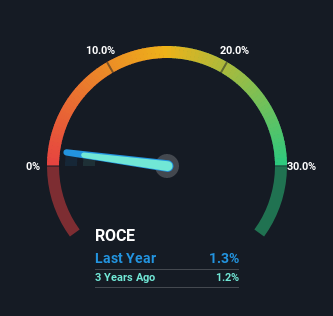Transocean Holdings Bhd (KLSE:TOCEAN) May Have Issues Allocating Its Capital

If you're looking for a multi-bagger, there's a few things to keep an eye out for. Amongst other things, we'll want to see two things; firstly, a growing return on capital employed (ROCE) and secondly, an expansion in the company's amount of capital employed. Basically this means that a company has profitable initiatives that it can continue to reinvest in, which is a trait of a compounding machine. Having said that, from a first glance at Transocean Holdings Bhd (KLSE:TOCEAN) we aren't jumping out of our chairs at how returns are trending, but let's have a deeper look.
Return On Capital Employed (ROCE): What Is It?
For those that aren't sure what ROCE is, it measures the amount of pre-tax profits a company can generate from the capital employed in its business. Analysts use this formula to calculate it for Transocean Holdings Bhd:
Return on Capital Employed = Earnings Before Interest and Tax (EBIT) ÷ (Total Assets - Current Liabilities)
0.013 = RM810k ÷ (RM69m - RM6.0m) (Based on the trailing twelve months to March 2022).
Therefore, Transocean Holdings Bhd has an ROCE of 1.3%. Ultimately, that's a low return and it under-performs the Logistics industry average of 5.1%.
Check out our latest analysis for Transocean Holdings Bhd

Historical performance is a great place to start when researching a stock so above you can see the gauge for Transocean Holdings Bhd's ROCE against it's prior returns. If you're interested in investigating Transocean Holdings Bhd's past further, check out this free graph of past earnings, revenue and cash flow.
What Does the ROCE Trend For Transocean Holdings Bhd Tell Us?
When we looked at the ROCE trend at Transocean Holdings Bhd, we didn't gain much confidence. To be more specific, ROCE has fallen from 1.8% over the last five years. Although, given both revenue and the amount of assets employed in the business have increased, it could suggest the company is investing in growth, and the extra capital has led to a short-term reduction in ROCE. If these investments prove successful, this can bode very well for long term stock performance.
On a related note, Transocean Holdings Bhd has decreased its current liabilities to 8.7% of total assets. That could partly explain why the ROCE has dropped. Effectively this means their suppliers or short-term creditors are funding less of the business, which reduces some elements of risk. Since the business is basically funding more of its operations with it's own money, you could argue this has made the business less efficient at generating ROCE.
What We Can Learn From Transocean Holdings Bhd's ROCE
In summary, despite lower returns in the short term, we're encouraged to see that Transocean Holdings Bhd is reinvesting for growth and has higher sales as a result. And the stock has done incredibly well with a 203% return over the last five years, so long term investors are no doubt ecstatic with that result. So should these growth trends continue, we'd be optimistic on the stock going forward.
One more thing, we've spotted 2 warning signs facing Transocean Holdings Bhd that you might find interesting.
While Transocean Holdings Bhd may not currently earn the highest returns, we've compiled a list of companies that currently earn more than 25% return on equity. Check out this free list here.
New: Manage All Your Stock Portfolios in One Place
We've created the ultimate portfolio companion for stock investors, and it's free.
• Connect an unlimited number of Portfolios and see your total in one currency
• Be alerted to new Warning Signs or Risks via email or mobile
• Track the Fair Value of your stocks
Have feedback on this article? Concerned about the content? Get in touch with us directly. Alternatively, email editorial-team (at) simplywallst.com.
This article by Simply Wall St is general in nature. We provide commentary based on historical data and analyst forecasts only using an unbiased methodology and our articles are not intended to be financial advice. It does not constitute a recommendation to buy or sell any stock, and does not take account of your objectives, or your financial situation. We aim to bring you long-term focused analysis driven by fundamental data. Note that our analysis may not factor in the latest price-sensitive company announcements or qualitative material. Simply Wall St has no position in any stocks mentioned.
About KLSE:ARKA
Arka Berhad
An investment holding company, provides logistics, tire manufacturing, and technology services in Malaysia and Singapore.
Mediocre balance sheet very low.
Market Insights
Community Narratives



